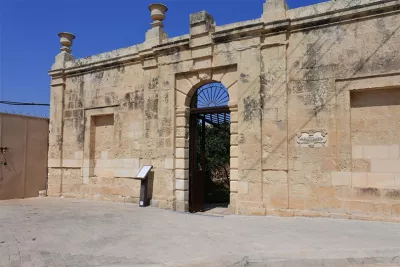General information
RDP Priority
- P6. Social inclusion and local development
RDP Focus Area
- 6B: Local development
RDP Measure
- M19: LEADER/CLLD
Beneficiary type
- Local / regional authority
Summary
CAP funding from a green infrastructure measure provided urgent restoration support for a 200-year-old heritage garden in the Maltese village of Ħal Safi. It was developed during the British Empire and originally set up by the Knights of St. John in an earlier century. The local council used Rural Development Programme Measure 19 (LEADER/CLLD) funds to revive 2 000 m2 of public gardens, which are now showcased in all their former glory. Families, children, grandparents and persons with special needs can now all enjoy the peace of this garden, giving a much-needed break from the hectic lifestyle of today. People visiting this garden can also learn more about local flora and fauna. This project has provided benefits to all the people who enjoy this garden and contributed to the overall green infrastructure of the locality.
Results
- Comprehensive restoration of a 2 000 m2 public garden into green infrastructure.
- Significant increase in residents and tourists visiting the garden’s green infrastructure.
- Improved accessibility for wheelchairs and families with children.
- Better irrigation possibilities.
- Creation of one part-time job for a gardener.
- Information plaques offer knowledge about local flora and fauna.
Resources
Documents
Good Practice Report - Restoration and embellishment of public gardens in a Maltese village
(PDF – 1.33 MB)
Context
The Sir Alexander Ball’s Garden of Ħal Safi is found in a village hosting some 2 600 people in the southern part of the main island of Malta. It is approximately 10 kilometres from its capital Valletta and was expanded during the early 19th century by the British. These gardens were part of the Maltese cultural heritage and provided a much-needed green space. After their private owner handed the garden to the local council, the grounds faced problems and needed improvement. Parts of the garden were not wheelchair accessible and the cisterns were not storing enough water. The idea behind this project was that the garden would be restored to its original glory with modernised irrigation and made more accessible and enjoyable for everyone.
Objectives
- An increase in the number of residents able to enjoy the garden.
- An increase in the number of tourists visiting the garden.
- To increase the water catchment of the garden and increase water savings.
- More visits from schools with the garden to be used as a learning experience for students..
- The creation of one part-time job (gardener).
Activities
- Preservation of the exterior walls and the façade of this historical garden following their restoration.
- Works carried out included making the lower part of the garden more accessible to the public, including creating a new passageway and a gazebo. This part of the garden was not accessible to the public before this intervention.
- Building a ramp at the main entrance and other garden areas to improve accessibility.
- Two large water cisterns underneath the garden were cleaned and conserved. Thanks to the work carried out on both reservoirs, rainwater is now being collected there.
- A drip irrigation system has been installed and connected to one of the reservoirs thus ensuring that trees and shrubs are watered regularly and maintained in good condition.
- More new citrus trees and new indigenous shrubs were planted throughout this project.
Information plaques in Maltese and English were installed and described the various trees and shrubs in the garden, as well as apiculture and the bees being nurtured in the garden by a local beekeeper.
Main results
- Comprehensive restoration of a 2 000 m2 public garden as green infrastructure.
- Significant increase of residents and tourists visiting the garden’s green infrastructure.
- Improved accessibility for wheelchairs and families with children.
- Better irrigation possibilities.
- Creation of one part-time job for a gardener.
- Information plaques offering knowledge about local flora and fauna.
Key lessons
- This project consisted of various tasks ranging from restoration, infrastructural works, landscaping, cleaning, and painting of reservoirs, installation of an irrigation system, installation of information panels, and so forth. In view of these diverse tasks, different contractors were involved throughout this project, which did not facilitate the project implementation stage. It was not easy to plan and coordinate between these different contractors, resulting in certain delays in finishing the project. Therefore, the engagement of a project manager to coordinate the various tasks involved in this project would have helped the implementation phase and ensured that the delivery of works stuck with the deadlines and thus delivered the project on time.
- An interesting aspect of implementing this project was the huge transformation of this historical garden from a state of neglect to a newly restored and embellished garden.
It is our national duty to preserve and also improve the condition of these historical tangible assets which were constructed by our ancestors so that present and future generations will also have the opportunity to enjoy them. Thus, I would strongly recommend the implementation of similar projects.
The expenses involved in the restoration and other works carried on historical places were relatively high. The total budget required for this project was substantial and financing it entirely through the Local Council’s funds would surely have not been possible. Therefore, the EU funds were fundamental to achieving this project.

